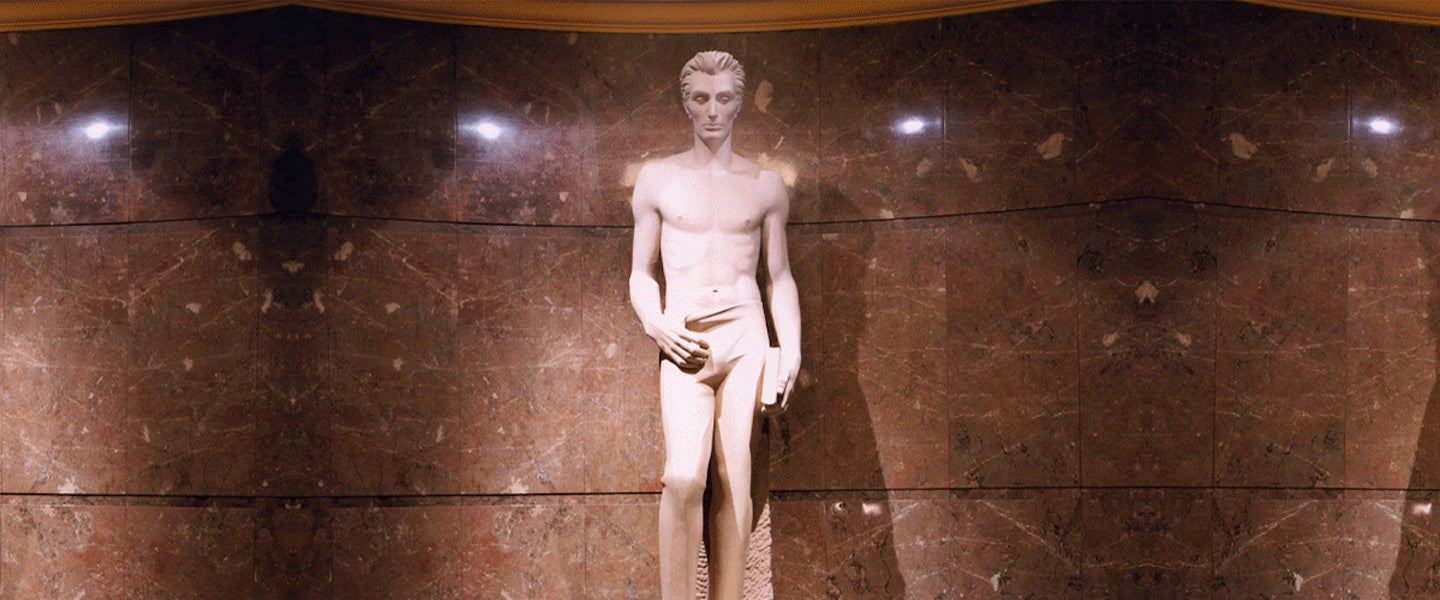For a brief, thrilling moment last week, Twitter took an interest in modern sculpture. The object of our fascination wasn’t particularly new, but it was unexpected: a statue of a buff, shirtless, fuccboi-esque Abraham Lincoln in the L.A. federal courthouse.
Reminder that the Los Angeles federal courthouse has a statue of Abraham Lincoln where he's a shirtless young stud suggestively tugging at his waistband like a Sports Illustrated swimsuit model: pic.twitter.com/32bjqEERYi
— Zack Stentz (@MuseZack) February 20, 2019
Thirsty comments and quips included “Babe-raham Lincoln,” “The Gettysburg Undress” and “Honest Abs.” Someone posted another hot Lincoln statue, this one in Chicago. Then MEL contributor Bill Black unearthed the amusingly Californian story of the L.A. version, which was sculpted in the early 1940s by a young artist who won a competition to do so — and used himself as a model. He sounded like something of a bad boy, too.
The guy who sculpted the Sexy Lincoln statue used himself as a model, and when he won the competition to sculpt it, he used the prize money to buy "a new car, promptly wrecked it, spent 18 days in jail"
Source: Life, Sept. 9, 1940 https://t.co/rNEglbyAXr pic.twitter.com/ZFO5PWto0D— Bill Black (@williamrblack) May 4, 2018
Idealizing the human form has long been an object of painting and sculpture, but in Lincoln’s case, the transformation is quite extreme. Compare the photos above with what people said about the Great Emancipator when he was alive: “So tall, lean, lank and ugly,” said Wesley Hall, a boyhood friend. “Thin as a beanpole and ugly as a scarecrow,” commented a neighbor in New Salem, Illinois. Journalist and railroad man Henry Villard remarked on his “odd-featured, wrinkled, inexpressive and altogether uncomely face.” These insults, writes Robert P. Watson in Affairs of State, a history of presidential sex and love, “dogged Lincoln his entire life,” causing terrible insecurities.
So weird, considering Lincoln is famous for being considered quite ugly in his day (upon being called two-faced): "If I had two faces, why would I wear this one?"
— Jonathan Gelling (@j_gelling) February 21, 2019
Lincoln also lived in the age of photography, so we can judge his attractiveness for ourselves. The true appearance of someone like George Washington — who did not have his portrait painted until age 40 — is more elusive. Most of us would think of his stern, tight-jawed face (owing to those spring-controlled wooden dentures) on the $1 bill, but historians have done their damndest to convince us that the first president was a hunk in his heyday. The late Jim Rees, who served as executive director of Washington’s Mount Vernon, once described him as the “most action-oriented, the most athletic and one of the most handsome of the founding fathers.” He oversaw a renovation of the site that included forensic imaginings of the younger Washington; these models had observers likening him to a quarterback or rock star. And the first president’s larger-than-life reputation in his own time owed something to similar flattery: Contemporaries wrote rapturously of his imposing height, muscles and physical grace.
Our national investment in that image is clear from two 19th-century sculptures of Washington. One, by an American artist, rendered him as a bare-chested Greek god with a flowing mane of hair. A few years prior, the Italian sculptor Antonio Canova had opted for a more sedate and pensive figure — complete with receding hairline. At a glance, you might not even guess that these are supposed to be the same guy:
@MuseZack Remember that there's a George Washington statue at the National Museum of American History that looks like this. pic.twitter.com/swWLiopMYD
— Keith Ivey (@kcivey) February 20, 2019
Interesting story behind Canova’s statue of George Washington, depicting the US president as a figure of classical restraint and nobility rather than youthful revolutionary vigor typical of the late 18th century @nytimes #July4th https://t.co/NlxpiVj88Q
— Troy Bramston (@TroyBramston) July 2, 2018
The story the U.S. tells about itself describes a land of vitality and rugged splendor, mastered by fearless men of robust character, which we like to symbolize with sterling physique. (See also: every action movie.) This requires a measure of vanity, enough to edit out Teddy Roosevelt’s paunch in statues, or let William Taft shed a few pounds, sometimes with help from his slimming Supreme Court justice robes. The Franklin Delano Roosevelt Memorial, dedicated in 1997, became a theater for the battle of accuracy versus iconography when it emerged that FDR, who suffered from polio, would not be depicted in the wheelchair he relied on throughout his presidency. Ghoulish pundits, including Charles Krauthammer, argued that because Roosevelt had concealed his disability from the public during his life, it was inappropriate to address this condition. Four years later, a statue with a wheelchair was added — a piece that was also radical in rendering a beloved leader as approachable and human-sized.
#OTD 2001, President Clinton unveiled the wheelchair statue at the FDR Memorial in D.C. https://t.co/6jA8Uxgb59 pic.twitter.com/r0uDfyco2l
— Presidential Trivia (@triviapotus) January 10, 2017
President Trump, in keeping with his brand of counter-realism, has tried to micromanage his own visual presence in real time. He’s almost definitely exaggerating his height and shaving down his true weight. His team posts digitally altered photos on social media that make him look thinner — and his stubby fingers, the subject of a decades-old Graydon Carter jab, seem longer. He hasn’t had his mushroom cock Photoshopped yet, as far as we know, but he’s the only man to ever defend the size of his penis during a presidential debate. Yet none of these efforts compare to the bodily propaganda of far-right cartoonist Ben Garrison, who loves to draw Trump as a brawny alpha dude instead of the pudgy loaf he obviously is. Every. Single. Chance. He. Gets.
I am obsessed with Ben Garrison's cartoon Trump, who is buff as shit and def not a septuagenarian who eats garbage and never exercises. pic.twitter.com/JC9mHSJFoE
— David Tveite (@tveitprivilege) June 15, 2017
Ben Garrison and Trump's abs, a story in three acts: pic.twitter.com/pXKMA7Zt4G
— Marc Channick (@Sorry_What_Now) January 7, 2019
the “make trump look like an aryan ubermensch” arms race is escalating, soon Ben garrison will portray him as one giant blonde chest muscle pic.twitter.com/CczdlSh0RV
— Easy Pete ☭ (@kodeinekyle) October 18, 2017
Only the coming century will tell whether Trump acquires that healthy glow in posthumous monuments, but it won’t be a surprise if he does. Our need to believe in the vim and vigor of past commanders-in-chief will overwhelm any memory of “executive time” or that horrorshow of a hairdo. While Trump is in office, we can paint him as a disgusting specimen all we want, and these barbs, like those Lincoln suffered, will fade into obscurity along with us. Because if the people we elect are fallible — if they are weak, unimposing, ailing or just plain mortal — then so are we, and so is this country. Why else are we so desperate for Dwayne Johnson to run for president?
So @TheRock mentioned if he were president, all elections would be settled by basically a tug of war over a really heavy metal pole.
And now I’m mentally ranking 2020 candidates by swoleness to see how they’d fare. #TitanGames
— Connor Mighell, Esq. (@cmigbear) February 22, 2019
Oh well. Better to be ruled by jocks than to keep on whitewashing Trump’s gut.

